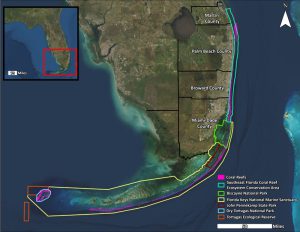As with many environmentally themed holidays, I consider them as taking place every day, and World Reef Awareness Day is no different.
Coral biology 101
Coral reefs are made up of a multitude of organisms, but the shining star of the group are the stony corals. Corals are some of the oldest and longest-living animals on the planet. Corals live as individuals called polyps, with many polyps making up coral colonies. Corals are invertebrates belonging to the phylum Cnidaria along with jellies and anemones. Corals are animals with very cool adaptations: they share a mutually beneficial relationship with microscopic algae that live in their tissues, zooxanthellae. The zooxanthellae photosynthesize and provide the coral with 80-85% of its nutrition. In return, the zooxanthellae receive room and board within the coral polyp. As they grow, corals secrete a calcium carbonate or limestone skeleton, which is the backbone of coral reefs.

Types of coral reefs
Around the world, three categories of coral reefs can be found. Fringing reefs forms along the coastline or land mass. An atoll is a circular-shaped reef that has formed by growing upward around a volcanic island that has sunk below sea level. A barrier or bank reef forms offshore and is separated from land by a lagoon or water body. Florida’s Coral Reef (FCR) is considered a barrier reef, and is one of the largest in the world, as well as the largest in the continental United States.
Florida’s Coral Reef
FCR stretches from the Dry Tortugas (70 miles west of Key West) though Monroe, Miami-Dade, Broward, Palm Beach, and Martin counties. This is approximately 360 linear miles of reef. In terms of managers, FCR has many cooks in the kitchen: the reef is managed by the Florida Keys National Marine Sanctuary, the National Park Service, John Pennekamp Coral Reef State Park, and the Florida Department of Environmental Protection’s Coral Reef Conservation Program. The newest section to receive “official” recognition is the northernmost 100-mile stretch of reef that extends from the northern border of Biscayne National Park in Miami-Dade County to the St. Lucie Inlet in Martin County. This section of the reef is now recognized as the Kristen Jacobs Coral Reef Ecosystem Conservation Area. All of these managing agencies share a common goal: to balance the sustainable use of as well as protect the reef.

Coral reef ecosystem services
Reefs around the world provide a multitude of ecosystem services (benefits that humans receive from natural systems). These include but are not limited to:
- Coastal protection: reefs serve as a natural barrier in storms, reducing wave height and energy, and mitigating flooding and erosion
- Biomedical benefits: many compounds for medicinal treatments come from organisms that live on coral reefs
- Food source: commercial and recreational fisheries species live on or near coral reefs
- Tourism and recreational opportunities: in Florida alone, the reef provides 61,000 jobs and $2bllion dollars in local income dollars.
Coral reef threats
Unfortunately, reefs in Florida and around the world face numerous natural and anthropogenic (human-caused) threats. These include:
- Coastal construction and dredging
- Overfishing
- Water quality and land-based pollution
- Warming ocean temperatures
- Diseases
- Physical impacts from boats and anchors
Many of these threats become compounded by others, which is why it is critical that we act locally as well as globally to reduce our impacts to these delicate ecosystems.

Ways to experience Florida’s Coral Reef
Since FCR comes so close to our shoreline, the opportunities to visit Florida’s Coral Reef are endless. Boating, fishing, snorkeling, SCUBA diving and paddling abound. Whether you want to get wet or stay dry, you can locate an ecotour company to serve as the vessel for your connection or rediscovery of the FCR. If you don’t know where to start, please contact me at azangroniz@ufl.edu and I will point you in the right direction. If you’d prefer to view FCR from the comfort of your own home, please check out Coral City Camera, an underwater camera at Port Miami that livestreams the reef 24 hours a day!
How to protect Florida’s Coral Reef
We all have a role to play in protecting our coral reef system and ensuring its health into the future.
From land:
- Choose reef-safe products such as sunscreen made with zinc or titanium oxide
- Purchase sustainably sourced seafood
- Refrain from purchasing corals or shells at gift shops
- Install native plants on your home landscape: they require less water and fertilization
- Make sure that any materials that you dispose of (paint, oil, etc.) are being done at the correct facility and not going down your drain
From water:
- Select eco-conscious tour operators for your reef adventure
- Avoid anchoring on reefs and use mooring buoys instead, or this reef locator app
- Keep debris inside your boat
- Recycle your monofilament fishing line
- If SCUBA diving, secure your gear so that nothing is dangling or dragging across the reef
What’s the most important thing that we can all do? Tell our friends and family about this wonderful resource. Happy World Reef Awareness Day!
 1
1
